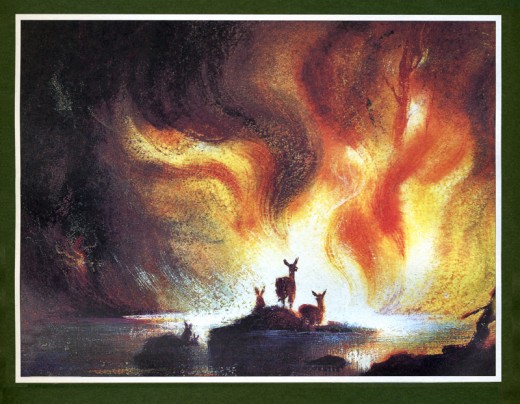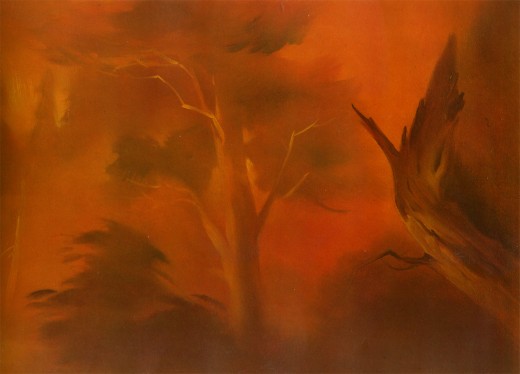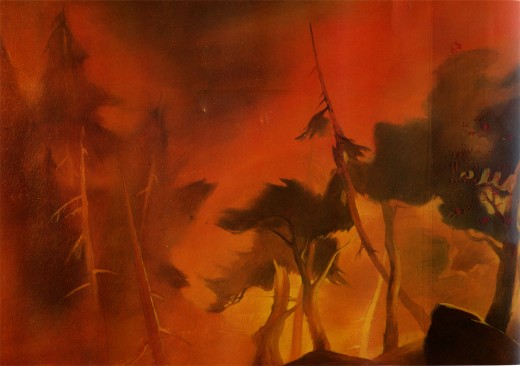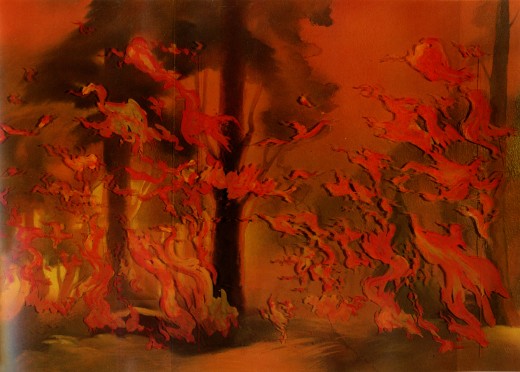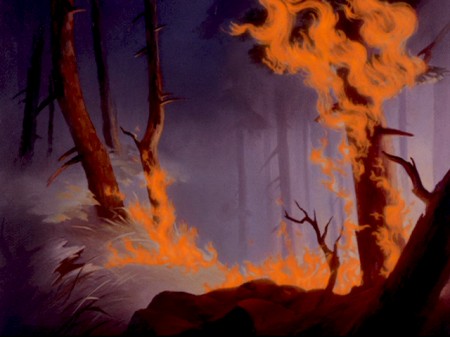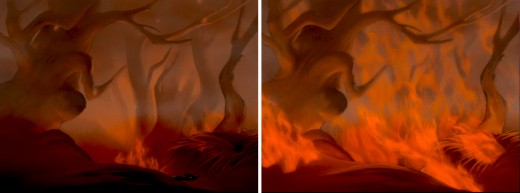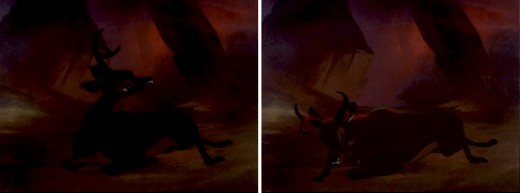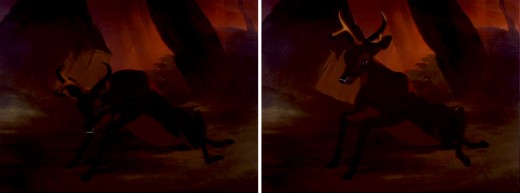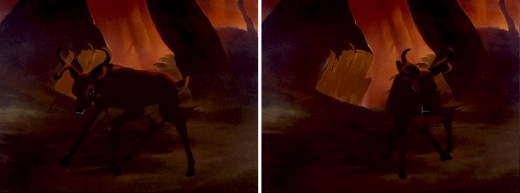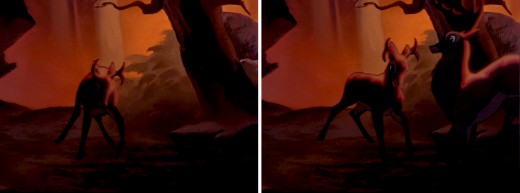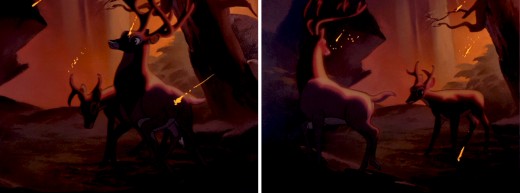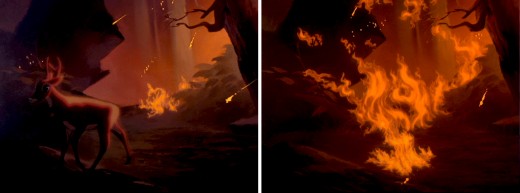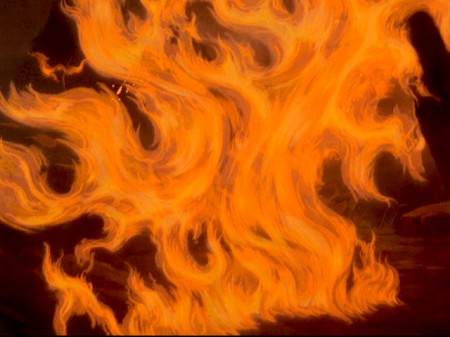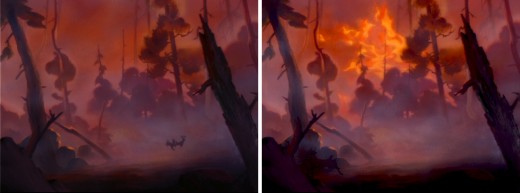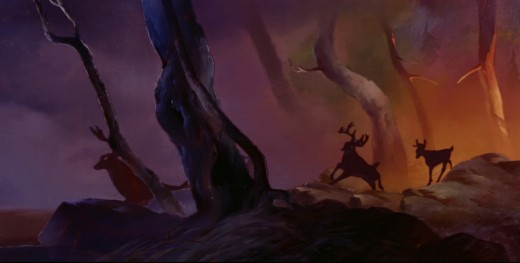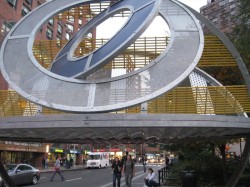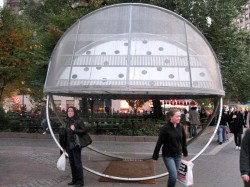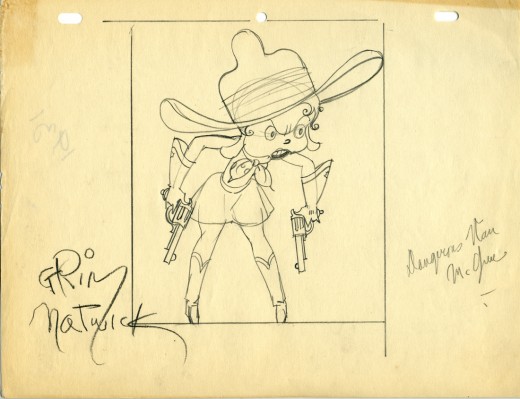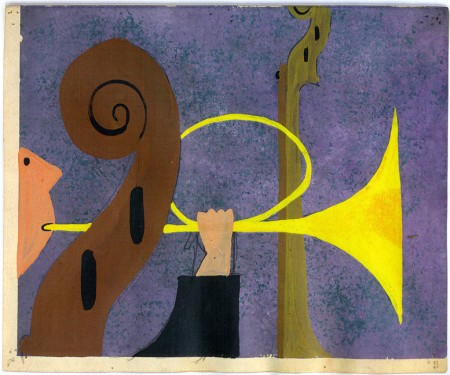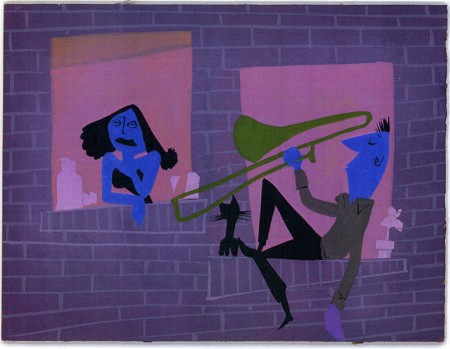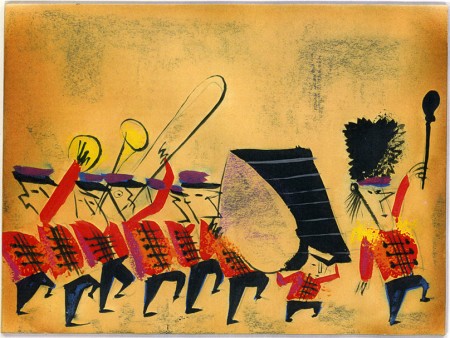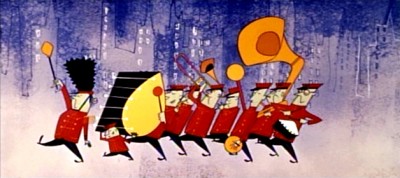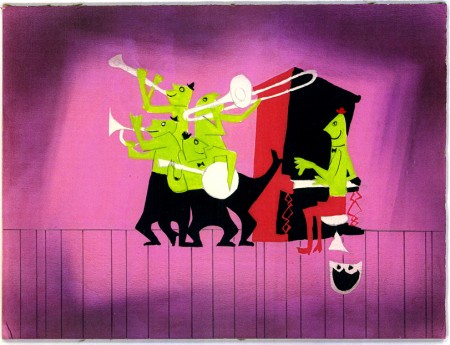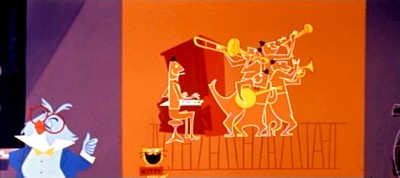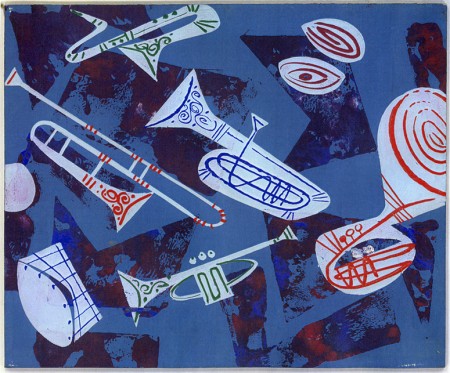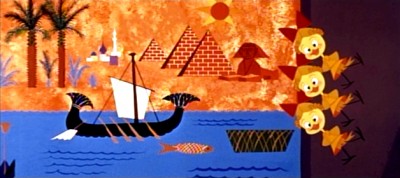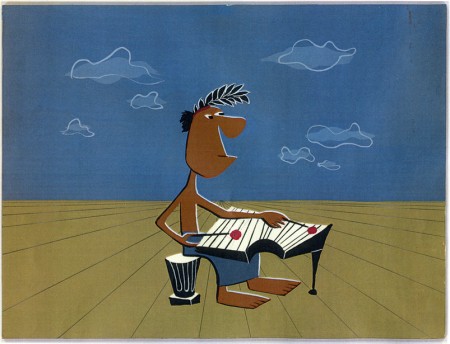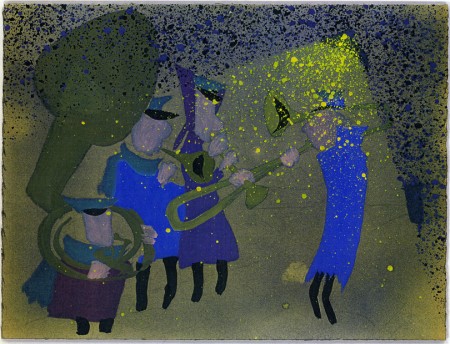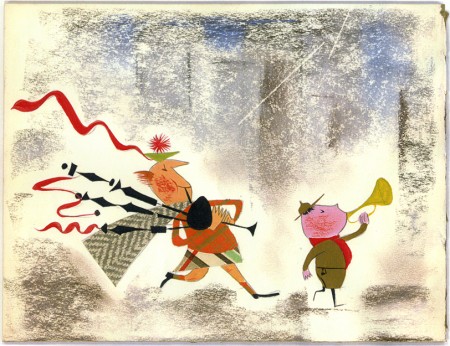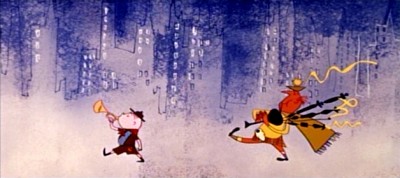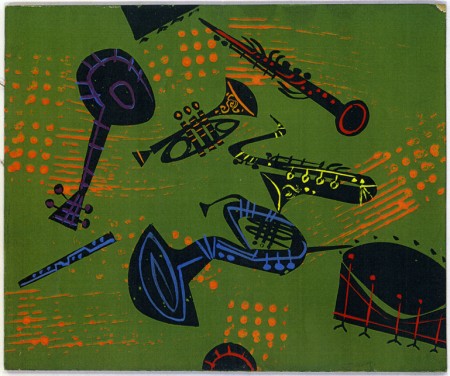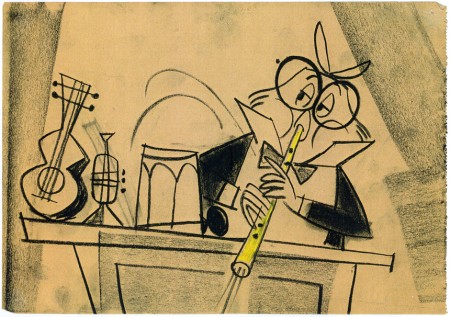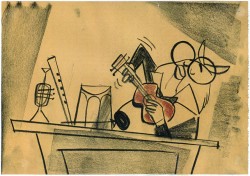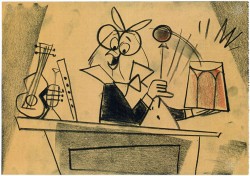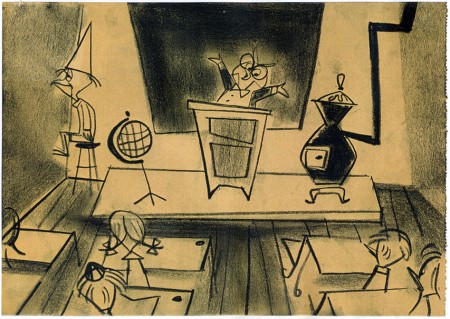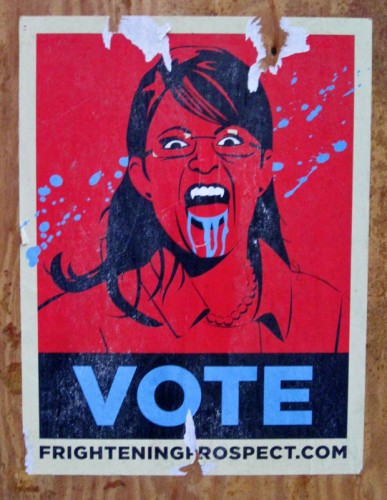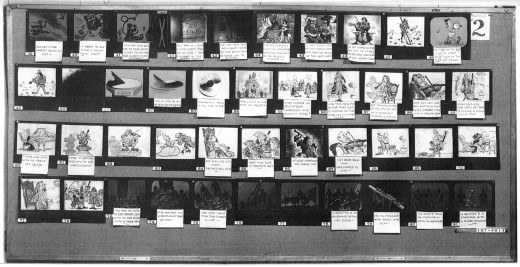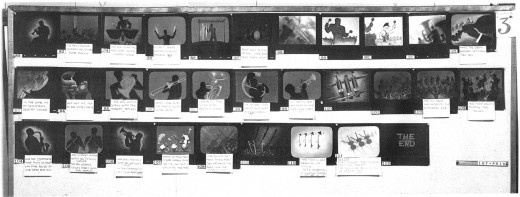Monthly ArchiveNovember 2008
Animation Artifacts &Books 10 Nov 2008 08:42 am
Fire!
- One of the great sequences in film, nevermind animation, is the forest fire in Bambi.
Here is storyboard sketch for the sequence.
Here are four backgrounds straight from John Canemaker‘s book, Treasures of Disney Animation Art. These four are all accredited to John Hubley.
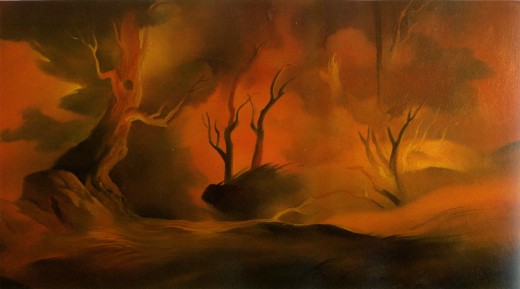
(Click any image to enlarge.)
Here are frame grabs from a couple of the scenes:
When the stag comes to save Bambi, lying on the forest floor – “Get up, Bambi. Get up! – the two scenes were made more dynamic by a special shoot wherein a strong light on a dimmer was set behind the background. As Bambi tried to lift himself, the light was slowly turned on lighting up the front of the scene as well.
Check out Hans Bacher‘s incredible sight for background reconstructions from this film. There’s a wealth of art in this movie. Two recent backgrounds shots that he’s posted are relevant to this sequence.
Art Art &Photos 09 Nov 2008 09:29 am
More Public Sculptures
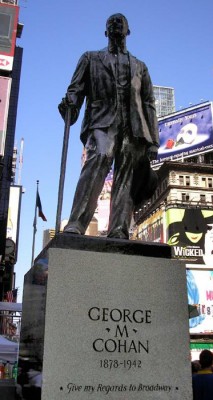 -One of the aspects I love enormously about living in NY is the appreciation of art in our daily lives. It’s everywhere. I enjoy displaying images of some of the sculpture I pass frequently.
-One of the aspects I love enormously about living in NY is the appreciation of art in our daily lives. It’s everywhere. I enjoy displaying images of some of the sculpture I pass frequently.
I’m not just talking, of course, of the many many recognizable personalities standing in bronze around all our parks and crossings but of many of the other non-representational pieces as well.
“Give My Regards to Broadway” composer, George M. Cohan (think James Cagney in Yankee Doodle Dandy” graces Times Square at Broadway & 46th Street. (This is actually called Duffy Square – a small triangle between 46th & 47th St named for Father Duffy, a noted military chaplain during WW I.) He greets all the visitors to Tin Pan Alley wherein he made his living.
Actually theaters moved to this area after the turn of the 20th Century. Prior to that the theatrical area was downtown some 10 blocks at Herald Square. (Both Squares were named for newspapers – Herald Sq. for the NYHerald, Times Sq. for the NYTimes.)
Regardless, this statue is a staple for all New Yorkers who usually take it for granted. ——————————————-.(Click any image to enlarge.)
.
Let’s move downtown to Union Square – 14th Street. The summer art program has deposited three large new sculptures. Dennis Oppenheim’s Tumbling Mirage.
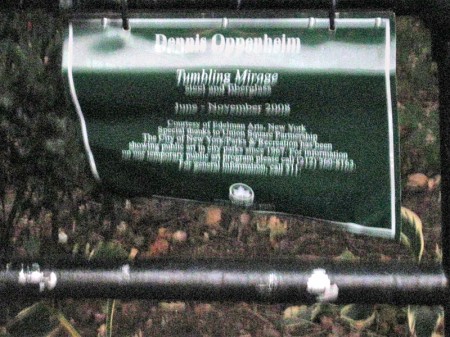
A somewhat dented sign gives us a small bit of information about the large pieces.
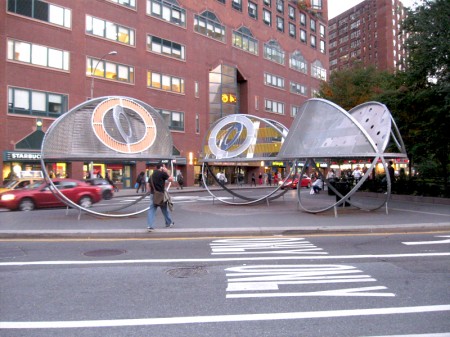
From the park at Union Square, you can look over to
the small traffic triangle to see the three pieces.
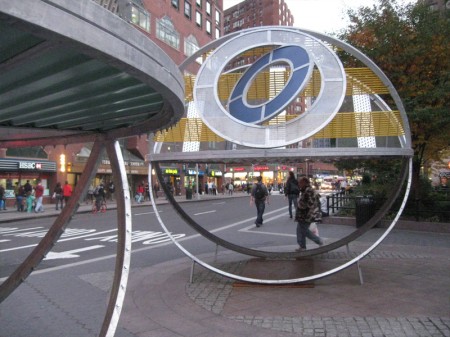
Crossing the street, you can walk in, through and around them.
Moving closer to my studio, there’s a very small children’s playground at Sixth Ave.
and Houston St. Within it is a small, child-sized sculpture of a seal.
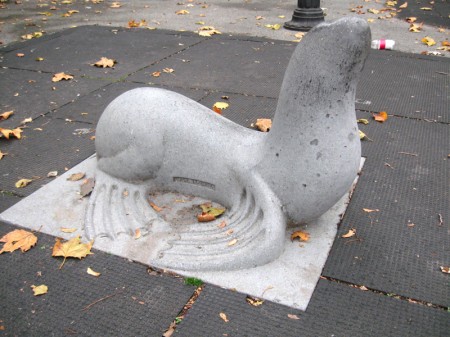
I see this piece daily, and I wonder how many others notice it. The stone
is worn down a bit for all the children who’ve touched it and ridden it.
No info seems to be there about the sculptor.
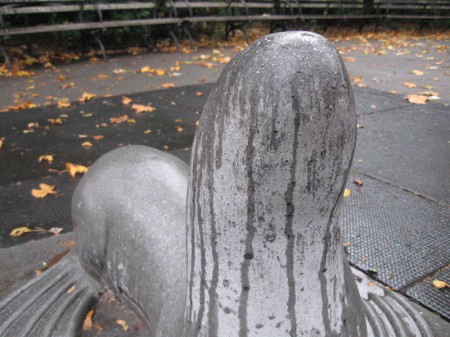
When I started photographing it, rain began to fall.
It made for interesting patterns on the stone.
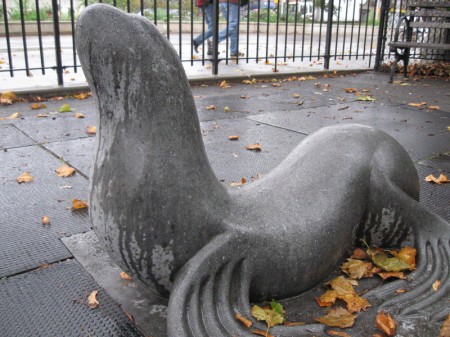
By the third and last photo, the rain was falling harder, and
the seal took on a different appearance.
Daily post 08 Nov 2008 09:33 am
Betty, Mononoke and Mickey
- An article appeared in yesterday’s Variety and then was picked up in the NYTimes announcing a new musical for Broadway. It’s being called the “Betty Boop Musical” at the moment, and it’ll be interesting to see what title they do arrive at. The show is expected to open during the 2010-11 season.
The music for the show is being composed by David Foster, the pop master who has written for Whitney Houston, Barbra Streisand and Josh Groban, among others. The book for the show will be written by Sally Robinson and Oscar Williams.
The show was originally announced in 2003, and Foster is the third composer attached to it. Jason Robert Brown and book writer David Lindsay-Abaire were originally attached. Andrew Lippa replaced Brown a year later and is now replaced by Foster.
 - In many ways, Princess Mononoke is one of my favorite of Myazaki’s films. The spirituality behind the film keeps me coming back to this beautiful animated epic. In many ways it synthesizes all that is great about Myazaki’s body of work.
- In many ways, Princess Mononoke is one of my favorite of Myazaki’s films. The spirituality behind the film keeps me coming back to this beautiful animated epic. In many ways it synthesizes all that is great about Myazaki’s body of work.
Now, a series of videos which details the making of this film has made it to YouTube. These videos have been collected by Daniel Thomas MacInnes into three seperate posts.
You can find them on his site, Conversations With Ghibli.
They’re broken into three groups. See:
Part 1,
Part 2, and
Part 3.
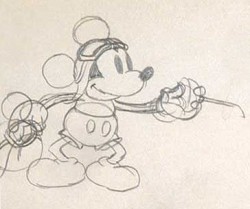 – Early animation art has always been a source of great inspiration for me. If you haven’t checked Bob Cowan‘s site recently you’ve missed the magnificent drawings he’s displayed from the Mickey short, The Mail Pilot. There’s a wealth of treasure on display with these beuatiful pencil sketches.
– Early animation art has always been a source of great inspiration for me. If you haven’t checked Bob Cowan‘s site recently you’ve missed the magnificent drawings he’s displayed from the Mickey short, The Mail Pilot. There’s a wealth of treasure on display with these beuatiful pencil sketches.
If you haven’t scrolled through this site, I urge you to do so. The Cowan collection is a gem. Production art for everything from Make Mine Music to Lady and the Tramp, Gulliver Mickey to Tarzan or Snow White. It’s all great and all worth drooling over.
I find it a bit odd that the link to a review for Madagascar 2 has been on the NYTimes front page since Thursday morning. I suppose I should be pleased that Dreamworks is obviously paying for this, but I’m disappointed in the Times.
By the way, is there any reason that animators these days can only do the fast-paced generic popping action for their characters. In cgi do you have to worry about how many drawings you make? There is virtually NO character animation being done anymore. All characters move the same way.
.
Articles on Animation 07 Nov 2008 09:05 am
John Oxberry
- An article chronicling the life of John Oxberry appeared in the April, 1975 issue of Animation Magazine. Oxberry was quite an interesting figure in the technical history of animation. He used some experiences in the Signal Corps to create a company around a series of animation cameras he developed and perfected. For so long, he was just a name built around the “Oxberry Camera” or “Oxberry pegs.” I think the articles worth reviving for your possible interest.
The man behind the machine
John Oxberry deserves more than the cursory glance afforded him
by the industry he served during a lifetime.
by Gary Comorau
Everyone in the film business has heard of an “Oxberry.” But other than the fact that it is bigger than a breadbox and that it has something to do with animation, much about this specialized equipment eludes the awareness of the average filmmaker. Even more shrouded in mystery remains the singular figure of the inventor and innovator who gave his name to an entire family of animation stands.
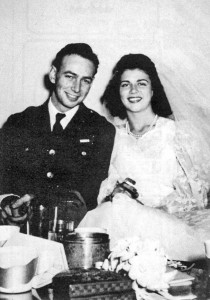 John Oxberry deserves more than the cursory glance afforded him by the industry he served during a lifetime; this pitifully miniscule obituary appeared in Backstage, in November, 1974:
John Oxberry deserves more than the cursory glance afforded him by the industry he served during a lifetime; this pitifully miniscule obituary appeared in Backstage, in November, 1974:
- “The well-known film inventor and developer, John Oxberry, passed away last week reportedly at the age of 58. His best-known achievements were in the animation field with the Oxberry stand, an industry standard.”
Millimeter Magazine was in the process of preparing an article on John Oxberry at the time of his untimely demise, which is why this interview ends so abruptly. Though we cannot hope to do justice to the memory of this pioneer in animation, nonetheless, by acquainting our readership with the life and work of this unassuming master-craftsman, we hope in some small measure to pay tribute to the man and the legacy he___John and June Oxberry, at
eft for future generations of filmmakers and movie-goers.____their wedding in Aug 1942.
It’s hard to say anything about John Oxberry without stumbling upon superlatives which to most listeners would sound exaggerated. He was unpretentious, yet incredibly knowledgeable; a pleasure to meet and a joy to talk to. Though considered by many to be a genius in his field, his wife describes him as “a simple, simple man.” He was a man who followed his heart, and he cheerfully invested his energies in animation, because of his fondness for this matchless medium and the people working in it. Thirty-five years in the business brought him many successes and failures, but he never sounded bitter about his setbacks. And after having opened many new vistas for exploration in his younger years, he embarked upon a personal quest to broaden the horizons for future animators by providing the possibility for sophisticated, but inexpensive Super-8 animation to anyone who wished to give flight to his imagination.
The scale of Oxberry’s business had changed in later years, but not his attitude towards it. At one time he built some of the most expensive and complicated animation equipment, and then, with the same enthusiasm, some of the least expensive. Producing quality equipment and having his name known throughout the industry did not make him rich and his modest ambition extended but to owning a boat, sailing and relaxing.
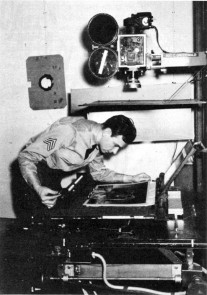 John Oxberry was born in 1918, in New Rochelle, N.Y. and spent most of his life in that area. His interest in film began at an early age, and when World War II broke out, he “got mixed up in the Signal Corps and worked on training films.” Eventually, the operation moved from Fort Monmouth to Astoria, New York, “…and we started doing animated films showing how to clean a rifle. It was your life…and we used to make these pictures for the Armed Service’s musicals once a month. Top talent would come in from studios and do that, and the medical stuff, like the sex pictures, which showed what one was supposed to do or not. We used to have to go see them every month…and then here we were making the damned things. So from that point on I wanted to get out of that mess, and thought it would be a good idea to make a piece of equipment that would top all that junk that we had had to work with. After WWII I decided to start a little
John Oxberry was born in 1918, in New Rochelle, N.Y. and spent most of his life in that area. His interest in film began at an early age, and when World War II broke out, he “got mixed up in the Signal Corps and worked on training films.” Eventually, the operation moved from Fort Monmouth to Astoria, New York, “…and we started doing animated films showing how to clean a rifle. It was your life…and we used to make these pictures for the Armed Service’s musicals once a month. Top talent would come in from studios and do that, and the medical stuff, like the sex pictures, which showed what one was supposed to do or not. We used to have to go see them every month…and then here we were making the damned things. So from that point on I wanted to get out of that mess, and thought it would be a good idea to make a piece of equipment that would top all that junk that we had had to work with. After WWII I decided to start a little
John Oxberry at Signal Corps______._company in New Rochelle.”
Photo Center, 1942.
Oxberry Products had been manufacturing top animation equipment since that time, under the ownership of John Oxberry, and during this time his name became synonymous with the best that the industry had to offer. Following a few bad business breaks, John sold the company to Berkey Photographic in 1970. He stayed with the company for awhile, but eventually decided that, “I didn’t want to stay there anymore…! didn’t like it. They gave me a contract, and money-wise it was very nice, but I didn’t like the work…I didn’t do anything, so I left. Then the company was sold to Richmark; they just bought it for the name. You know, I never did get paid for my name…Dick McCarthy over there says, “You know, you can’t use that.’ And I said, ‘Yeah, are you going to pay the rent? I have to sign John Oxberry every month. I’ll go along with you; you can call me Joe Schitz if you want, but you’ll have to pay for it.’ ”
From that time on John was on his own again, doing design work for friends and developing new products. One of these is the Supermation stand, a small unit selling for around $100, and now manufactured by Ox Products, in Ma-maroneck, N.Y. He hoped it would introduce animation to people who would have had little possibility otherwise to experience for themselves the joy and satisfaction it provides. “I decided to get back into things again. I think it will foster interest in an entirely new group of people who haven’t the slightest idea of what went into it originally. A hundred dollars is a joke. Just the lens to collect light for the operable burner cost four hundred. This whole damn stand would sell for $98.50.”
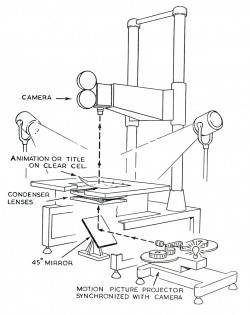 For this amount and with a Super-8 camera anyone could animate. It was not designed for professional work, but for families, schools and filmmakers who wanted a stand to play with. An animation kit was also being assembled to familiarize neophytes with the tricks of the trade. It would explain the rudiments of animation, how to work with cycles such as a person running, walking, etc., and other effects which could be achieved easily and economically.
For this amount and with a Super-8 camera anyone could animate. It was not designed for professional work, but for families, schools and filmmakers who wanted a stand to play with. An animation kit was also being assembled to familiarize neophytes with the tricks of the trade. It would explain the rudiments of animation, how to work with cycles such as a person running, walking, etc., and other effects which could be achieved easily and economically.
John Oxberry was interested in animation as an art form, as a means of recreation and self-expression, not just as a business. His knowledge of film in general was amazing, and he continually worked toward furthering his understanding. He didn’t care much about becoming famous; he just wanted to work, to learn, and to enjoy whatever he was doing. His basic grasp of concepts and their relation to each other enabled him to keep things in perspective. “I always avoided getting involved on the subject of lights. Everybody has his own idea of how lights should be, and you can argue about them till the year one. It’s a peculiar thing…a lot of people don’t realize it, but when taking a picture in animation, it doesn’t make a difference whether your color temperature is right or wrong. But they think, ‘Gee, it’s got to be just right for the platinum glass.’ They call it an optical flap. An eight-by-ten piece of optical flap costs around $25,000, and they don’t even know what it is. If you put down a background, any background, nobody knows what color was originally chosen. They only see what’s on the screen. What are they going to compare it with? Now if we had a pretty girl with pink cheeks, and we could make a Turner girl out of her or something like that, we could see the difference; everybody would know. You could look at the face, the pink cheeks, and the little blonde hairs on the eyebrows, and you could compare with a memory. But in animation, you haven’t seen the original so there’s nothing you could compare it with. I would like to see the color temperature of a light that’s practical to use. But down at the hardware store, I could buy two showcase lamps, and the color temperature may be 2700, way down at the bottom. Things will look a little redder, perhaps, so I think a little bluer when I’m drawing. Now they last for one year, and cost a dollar and a half, so I think a little blue…that’s all.”
John Oxberry was a quiet almost solitary individual in the film industry. His name was never up in lights and some will say that his achievements have been sorely neglected. But if a man’s work is any measure of his greatness or importance, then John Oxberry’s prominence as an artist and craftsman is undoubtedly beyond question.
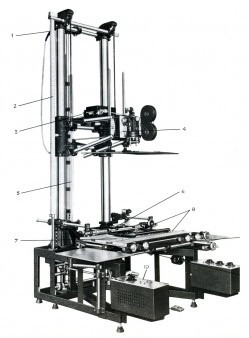
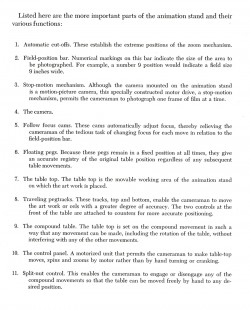
Details of an “Oxberry Animation Stand”
from Eli Levitan’s Animation Art in the Commercial Film
Animation Artifacts &Disney &Layout & Design &Story & Storyboards 06 Nov 2008 08:59 am
Toot Art – 2
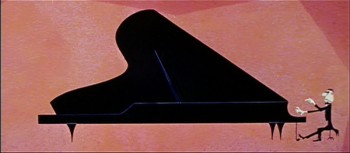 - Last week, I posted the first installment of this series of storyboard art from Toot Whistle Plunk & Boom. Here’s the second installment of these photostats loaned to me by John Canemaker.
- Last week, I posted the first installment of this series of storyboard art from Toot Whistle Plunk & Boom. Here’s the second installment of these photostats loaned to me by John Canemaker.
I might also note that a number of these were posted by Amid Amidi on his site, Cartoon Modern back in Jan, 2007. Those are worth posting again, and others haven’t been posted before.
When some of the images are close, I’ve tried to give frame grabs that match. Ward Jenkins has many frame grabs from the entire film on his site.
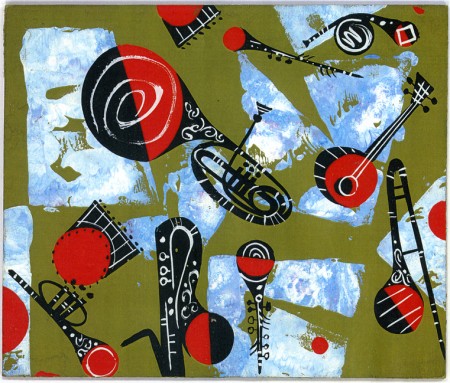 17
17(Click any image to enlarge.)
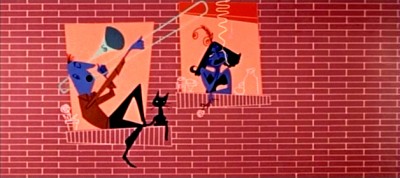
To me, this frame grab captures the spirit but loses some of the art.

This is a very interesting choice. The original is beautiful, and this is too.
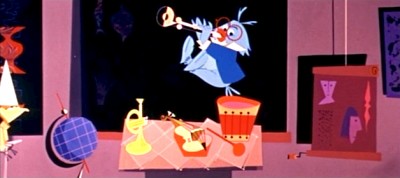
Owl plays all of the instruments at the film’s start.
This is a good representation.
Commentary 05 Nov 2008 09:23 am
Enormous
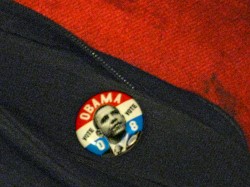 - I have to say I’m pleased. It’s going to be a good day.
- I have to say I’m pleased. It’s going to be a good day.
Juneteenth was a “holiday” they celebrated in the South when whites gave blacks a day off. This celebratiion of the day Lincoln told the slaves they were free was the only day African-Americans were allowed to visit the parks in the South; the only day they could go to the zoo. This in the ’60s!
Finally, America, including parts of the South, truly stepped beyond this “holiday” by creating an even better one.
Yeah, I’m pleased.
And to top that racist consideration, this is one excellent choice of a man to take charge of the Country. Someone who can pronounce the word nuclear and understands his own actions.
The system works in some odd way. A convicted felon was elected to the Senate in the state of Alaska. Perhaps Bush can pardon him before he leaves office as one last act of chaotic egotism.
It also seems like Al Franken lost to Norm Coleman, in the closest of races. Talk of recount is already in the air.
We also have Michelle Bachman back in Congress. Perhaps, she can now get her investigation going so that we can find out who the Anti-Americans are.
It’ll also be interesting to see Joe Lieberman join the Democratic caucus again.
John McCain gave a fine speech last night, but how does he resolve the hatred and venom he and his running mate left behind them? Now, the Country has to get beyond that. A lot of their followers believe that Obama is a socialist! I’ve heard that word on the radio at least a dozen times in the last hour.
I just can’t wait until those two little kids (and their puppy) will be living in the White House. I’m happy. Barack Obama is our next President.
Commentary 04 Nov 2008 09:28 am
Vote
Animation Artifacts &Disney &Story & Storyboards 03 Nov 2008 08:55 am
Toot Bd – 2
- This is a later storyboard for Toot Whistle Plunk & Boom. Last week I posted an earlier board (pt 1 & pt 2), and the focus, here, is a bit different. This is called “Meet the Instruments” for a reason.
There’s not much indication of the film that will actually grow out of this and is closer to the story artwork I started posting last week and will continue with plenty more later this week.
This comes from the collection of John Canemaker, many thanks to him.
Here’s the entire board (it’s considerably shorter) in three stats:
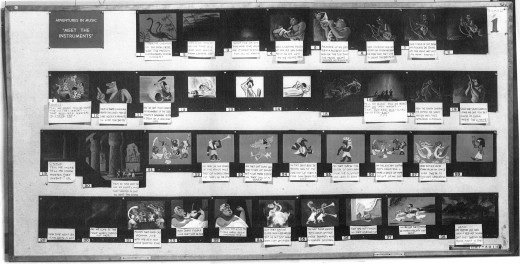 1
1(Click any image to enlarge.)
And here’s the board broken down to allow for enlarging it:
 11a
11a
Photos 02 Nov 2008 09:13 am
Pulse Park
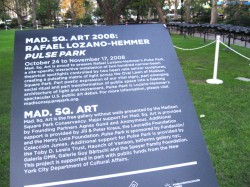 - A couple of weeks ago, I noted in a post that a large bank of theatrical lights had been placed in a circle on the Oval Lawn of Madison Square Park. This obviously indicated that a new “Art” piece was in the works. Little did I know that the lights WERE the art piece.
- A couple of weeks ago, I noted in a post that a large bank of theatrical lights had been placed in a circle on the Oval Lawn of Madison Square Park. This obviously indicated that a new “Art” piece was in the works. Little did I know that the lights WERE the art piece.
Rafael Lozano-Hemmer’s Pulse Park is an interactive light installation that monitors visitors’ heart rates using two heart rate sensor sculptures, and activates two hundred theatrical spotlights, creating a pulsating matrix of light across the central Oval Lawn of the historic park.
According to the Park’s information about the piece:
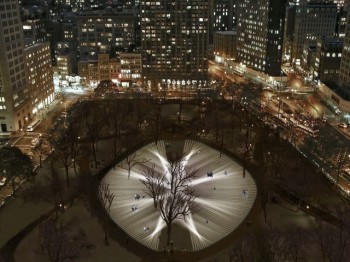 Pulse Park marks the U.S. public art debut of Rafael Lozano-Hemmer. In Pulse Park, evening visitors to Madison Square Park will have their systolic and diastolic heart rates measured by one of two sensor sculptures installed at the North and South ends of the Oval Lawn. These biometric rhythms are translated and projected as pulses of narrow-beam light that will move sequentially down rows of spotlights placed along the perimeter of the lawn as each consecutive participant makes contact with the sensors. The result is a poetic expression of our vital signs, transforming the public space into a fleeting architecture of light and movement.
Pulse Park marks the U.S. public art debut of Rafael Lozano-Hemmer. In Pulse Park, evening visitors to Madison Square Park will have their systolic and diastolic heart rates measured by one of two sensor sculptures installed at the North and South ends of the Oval Lawn. These biometric rhythms are translated and projected as pulses of narrow-beam light that will move sequentially down rows of spotlights placed along the perimeter of the lawn as each consecutive participant makes contact with the sensors. The result is a poetic expression of our vital signs, transforming the public space into a fleeting architecture of light and movement. 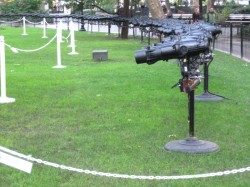

During the daytime the lights look like this.
At night, the lights come in waves and create glowing patterns on the very bright green grass. Semi silhouetted people flicker about on the grass and move in the strobe light glows. Then it goes dark, and you wait another couple of seconds before the next wave begins. It was quite surreal and very interesting. Here are some stills.
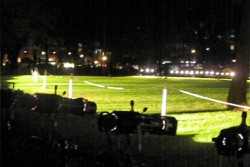
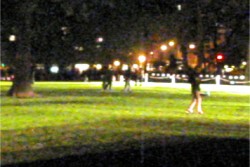
If you look closely, you’ll find some people traipsing about.
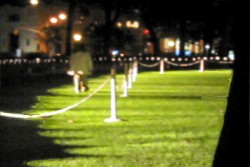
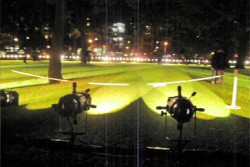
I expected to have lights flashing in my eyes, but
that was never a problem.
I went the first non-raining night I could, last Monday, and recorded this short film on my camera to give you an idea of what you see in the dark of the park.
There’s a short item in The Gothamist about it.
New York Magazine had another, similar article.
Postnote: My photos were taken last Monday. Two days later half the lights were down, and by Friday they were back. I went by last night at around 7pm, and the piece was dark. I’m not sure when exactly they’re operating.
Daily post 01 Nov 2008 08:59 am
Arlene Sherman and Toe Tactics
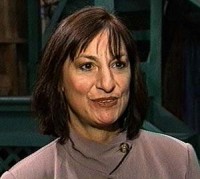 - Many years ago, Edith Zornow was my guardian angel at Sesame Street – I mean CTW. Whenever my tiny company was in desperate trouble and one short step away from crumbling, Edith would pop up with some spots for me to do, and things became just fine again. I have to say I loved Edith; it wasn’t the usual client relationship. She suffered from Parkinson’s Disease which slowly grew worse over a few short years. Eventually, she died, and I felt my world was doomed.
- Many years ago, Edith Zornow was my guardian angel at Sesame Street – I mean CTW. Whenever my tiny company was in desperate trouble and one short step away from crumbling, Edith would pop up with some spots for me to do, and things became just fine again. I have to say I loved Edith; it wasn’t the usual client relationship. She suffered from Parkinson’s Disease which slowly grew worse over a few short years. Eventually, she died, and I felt my world was doomed.
Arlene Sherman took Edith’s place, and was just as supportive. I worked with Arlene for many years producing lots of animated bits for the show and other shows. One time we even did a number of films in Arabic for a Mid-East version of Sesame Street.
Arlene just died this past week, and I’m tremendously sad.
We hadn’t worked together in a number of years, but she lived in the neighborhood of my studio, and we often passed on the street. Always an embrace, always I felt things were right in the world after meeting her.
I found this “Paid death notice” in the NY Times. I haven’t found any obits other than the one on AWN. At least there’s the one. I just had to report this, though I wish I had more details.
I also have to admit sadness on hearing of the death of Studs Terkel. It was comforting just knowing someone of his calibre was in the world.
I’ll be sad to see King of the Hill go, now that it’s been cancelled. I don’t watch every week, but I watch it often enough. However, we do have to make room for The Cleveland Show. Sunday will soon be an all Seth McFarland night. It’s interesting that the NY Times felt it important enough to deliver an article.
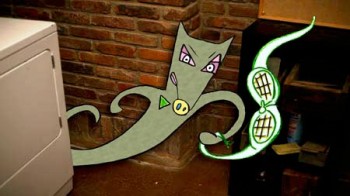 - Emily Hubley informs me that her feature film, The Toe Tactic is going to have a number of screenings upcoming for the local area.
- Emily Hubley informs me that her feature film, The Toe Tactic is going to have a number of screenings upcoming for the local area.
Please take note of dates and times, and get out to see an exciting and different kind of movie.
Here are some places, dates and times:
- Jacob Burns Film Center in Pleasantville NY
November 5th, 7pm with Producer Jen Small and Emily Hubley in attendance.
Go here to order tickets to this event.
92Y Tribeca (200 Hudson St, NYC)
November 20th, 8pm
Discussion follows with Emily Hubley and friend Judith Helfand.
Go here to order tickets for this event.
Clearview’s South Orange 5 (NJ)
December 4th with a 7pm Filmmaker Reception and Q&A with Emily Hubley to follow.
Clearview’s South Orange 5 (NJ)
December 10th – 7pm
Go here to order advance tickets.
The Toe Tactic will have its theatrical premiere at The Museum of Modern Art from January 28th – February 2nd, 2009 (screening times vary).
MOMA’s schedule doesn’t have this program listed, as yet. Check here next month.
Tell one and all!
- Nina Paley tells of some upcoming screenings of her feature, Sita Sings the Blues. These are as follows:
 There are two matinees at the New York Children’s Film Festival which screens at the IFC theater on Sixth Ave and 3rd Street:
There are two matinees at the New York Children’s Film Festival which screens at the IFC theater on Sixth Ave and 3rd Street:Saturday, Nov. 8, 11:00 am
Sunday, Nov. 9, 11:00 am
There are two screenings at MoMA, as part of IFP’s Gotham Awards series for nominees in the category “Best Film Not Playing At A
Theater Near You” (undistributed features):
Thursday Nov. 20, 6:00 pm
Saturday Nov. 22, 3:00 pm
